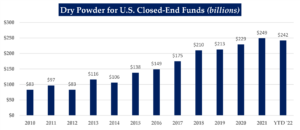The release date for the next month’s year-over-year inflation figure has become the most anticipated date on the financial calendar. It’s like waiting to receive the letter of acceptance or denial from the college of your choice. It is not hard to understand why – the 9.1% recent inflation figure is the highest in forty years! Most of us in the financial and real estate industries have never seen this level of inflation, and if you are under forty years old, you have never worked in an environment where interest rates are rising quickly.
Here is one way to think about the current inflationary environment. If you purchase a three-year treasury bill at a 3% yield today, your current real rate of return is negative 6.1%. Or, if you own an apartment building and your rents have risen 5% over the last year, you feel pretty good, but your NOI growth will likely fall short of that increase and may even drop as expenses continue rise in excess of rental rates. Over the long term, endowments and foundations generally look to receive a real rate of return of around 5% above inflation and an expense load of around 1%. That means to hit their targets in the current environment, they need a whopping 15% return! It is no wonder that inflation is on our minds, and if the Fed must make a choice between risking a recession to control inflation or letting inflation continue substantially above their target, our bet is they will lean in the direction of tighter and tighter monetary policy.
The uncertainty created by the war in Ukraine, the prospect of global food shortages, supply chain challenges, the lingering pandemic, and labor shortage in the US have all in some way contributed to inflation. We all want to know how long it will last and what our strategy should be while we wait. In the real estate sphere, transactional volume has slowed to a crawl over the last couple of months with some buyers staying on the sidelines while others are looking for distressed pricing. Lenders are pulling back, as well. The Mortgage Bankers Association recently projected a decrease of 18% in mortgage originations in 2022 from 2021 even after a record setting first half of the year. As has happened at previous inflection points (downturns), owners are not in any hurry to sell at lower prices, so we see the current environment persisting well into the fall.
During times when the crystal ball is not clear and fear begins to take over the markets, it is instructive to look at the fundamentals. In most real estate asset classes, the fundamentals look strong. In the US and in the Washington area, for example, we see a continued shortage of housing. While mortgage rates have risen substantially and there has been some softening in the market, buyers and renters are still competing for houses and apartments. This demand driven market is a countervailing force to the dampening effect of higher interest rates.
In the institutional real estate market, there continues to be lots of equity capital available. The chart below from JLL reflects the amount of capital raised by closed end funds over the last few years. Furthering the trend through the turbulent second quarter, Blackstone, the largest real estate investment manager in the world, raised over $250 million per day for its institutional global opportunity fund while its retail investor focused BREIT raised over $2 billion per month. With this amount of dry powder waiting on the sidelines, it is hard to imagine prices falling substantially.

Looking at the fundamentals provides some reassurance during this time of uncertainty. Continued strong demand for residential and industrial products, a more balanced labor market, investment capital at the ready and the inflation protection aspects of real estate are all reasons to be cautiously optimistic.
